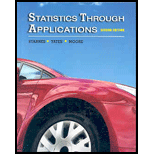
Concept explainers
a)
To explain the shape, center and spread of the sampling distribution of the sample proportion.
a)
Answer to Problem 9.17E
Explanation of Solution
Given:
P = 14% = 0.14
n = 600
Formula:
Standard deviation:
Calculation:
The mean =
The standard deviation:
The sampling distribution of sample proportion
b)
To explain whether your sample to contain 18.2% or more who own Harleys.
b)
Explanation of Solution
Given:
Sample proportion =
Formula:
Calculation:
First we need to find z-score,
Therefore,
P(Z> 2.96) = 1-P(Z<2.96) = 1-0.9985 = 0.0015 …Using excel formula, =NORMSDIST(2.96)
This probability is less than 0.05, which indicate that the
c)
To explain whether your sample to contain less than 12% or more who own Harleys.
c)
Explanation of Solution
Given:
Sample proportion =
Formula:
Calculation:
First we need to find z-score,
Therefore,
P(Z< -1.41) = 0.0793 …Using excel formula, =NORMSDIST(-1.41)
This probability is more than 0.05, which indicate that the event likely to occur by chance.
Chapter 9 Solutions
Statistics Through Applications
Additional Math Textbook Solutions
Elementary Statistics: Picturing the World (7th Edition)
Elementary Statistics (13th Edition)
Pre-Algebra Student Edition
Precalculus
Algebra and Trigonometry (6th Edition)
A First Course in Probability (10th Edition)
- The following data represent total ventilation measured in liters of air per minute per square meter of body area for two independent (and randomly chosen) samples. Analyze these data using the appropriate non-parametric hypothesis testarrow_forwardeach column represents before & after measurements on the same individual. Analyze with the appropriate non-parametric hypothesis test for a paired design.arrow_forwardShould you be confident in applying your regression equation to estimate the heart rate of a python at 35°C? Why or why not?arrow_forward
- Given your fitted regression line, what would be the residual for snake #5 (10 C)?arrow_forwardCalculate the 95% confidence interval around your estimate of r using Fisher’s z-transformation. In your final answer, make sure to back-transform to the original units.arrow_forwardCalculate Pearson’s correlation coefficient (r) between temperature and heart rate.arrow_forward
 MATLAB: An Introduction with ApplicationsStatisticsISBN:9781119256830Author:Amos GilatPublisher:John Wiley & Sons Inc
MATLAB: An Introduction with ApplicationsStatisticsISBN:9781119256830Author:Amos GilatPublisher:John Wiley & Sons Inc Probability and Statistics for Engineering and th...StatisticsISBN:9781305251809Author:Jay L. DevorePublisher:Cengage Learning
Probability and Statistics for Engineering and th...StatisticsISBN:9781305251809Author:Jay L. DevorePublisher:Cengage Learning Statistics for The Behavioral Sciences (MindTap C...StatisticsISBN:9781305504912Author:Frederick J Gravetter, Larry B. WallnauPublisher:Cengage Learning
Statistics for The Behavioral Sciences (MindTap C...StatisticsISBN:9781305504912Author:Frederick J Gravetter, Larry B. WallnauPublisher:Cengage Learning Elementary Statistics: Picturing the World (7th E...StatisticsISBN:9780134683416Author:Ron Larson, Betsy FarberPublisher:PEARSON
Elementary Statistics: Picturing the World (7th E...StatisticsISBN:9780134683416Author:Ron Larson, Betsy FarberPublisher:PEARSON The Basic Practice of StatisticsStatisticsISBN:9781319042578Author:David S. Moore, William I. Notz, Michael A. FlignerPublisher:W. H. Freeman
The Basic Practice of StatisticsStatisticsISBN:9781319042578Author:David S. Moore, William I. Notz, Michael A. FlignerPublisher:W. H. Freeman Introduction to the Practice of StatisticsStatisticsISBN:9781319013387Author:David S. Moore, George P. McCabe, Bruce A. CraigPublisher:W. H. Freeman
Introduction to the Practice of StatisticsStatisticsISBN:9781319013387Author:David S. Moore, George P. McCabe, Bruce A. CraigPublisher:W. H. Freeman





